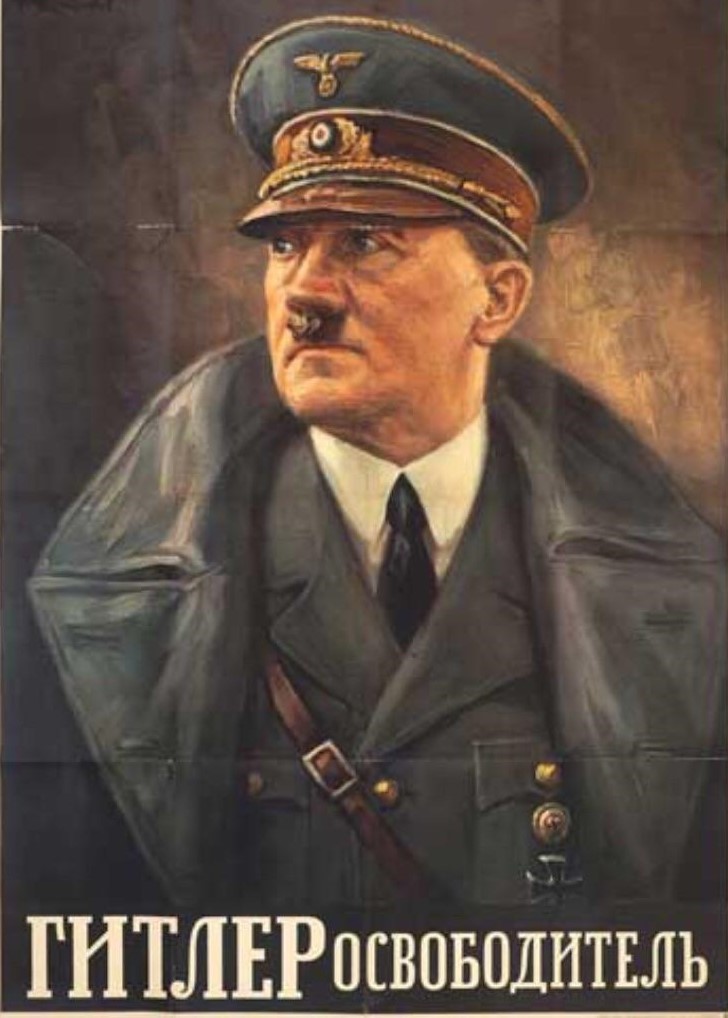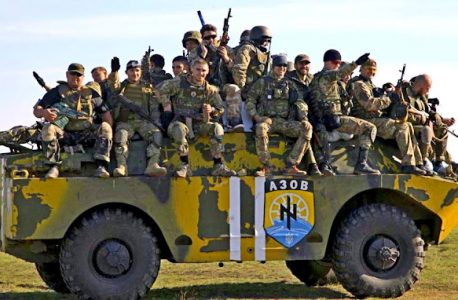By Karl Haemers for the Occidental Observer
In the current conflict between Ukraine and its Western allies versus Putin’s Russia, both sides have blamed the other as being “Nazis”. The Jewish comedian and actor become Ukrainian President Volodymyr Zelensky said “Russia attacked Ukraine in a cowardly and suicidal way like Nazi Germany did during World War II.”[1] For his part, Putin declared in his address of February 24, referring apparently to the role of the Azov battalion in the fighting in eastern Ukraine: “The purpose of this operation is to protect people who, for eight years now, have been facing humiliation and genocide perpetrated by the Kiev regime. To this end, we will seek to demilitarize and de-nazify Ukraine.”[2]
Both statements may appear to have some validity, though the irony and clownish accusations of each side calling the other “Nazis” is inevitably humorous. Putin’s comment seems to have more validity, since circumstances between Ukraine and Russia today are far different than between Ukraine and Germany in 1941. Conversely, news of “Neo-Nazis” in Ukraine have permeated Western media for years, with reporting on such groups as Azov Battalion and umbrella group Right Sector, among others.
Much can be said about this phenomenon of National Socialist and affiliated groups and interests persisting in Ukraine to this day, but here we will focus on the historical roots of why “Neo-Nazis” are said to exist with such prominence in Ukraine today.
Before dawn on June 22 1941, the National Socialist armies, formally joined by the soldiers of Hungary, Rumania and Italy, as well as soldiers from many other nations in the Waffen SS, launched Operation Barbarossa.[3] Stalin had impoverished the USSR assembling and equipping the world’s largest horde of armies, which were poised on the mutual border with Germany via the then double-occupied Poland. Arranged in two Strategic Eschelons, all Soviet defensive structures and forces had been removed, and Stalin’s immense Red Army was preparing to launch a devastating offensive attack into Germany and onward to seize all of Europe.[4]
Hitler and the National Socialist Germans and their allies struck first in a bold pre-emptive strike on a scope and scale the world had never seen. Three immense columns of troops, tanks, armaments of every kind, and supplies, accompanied by the Luftewaffe forces in the air, surprised the Soviets and immediately captured huge war supply depots and hundreds of thousands of enemy soldiers.
The southernmost of the three columns commanded by General von Rundstedt (of Dunkirk fame) had as its objective Kiev in the Ukraine and the Caucuses mountains beyond. It was this column which the Hungarians and Rumanians joined, equipped with arms taken from the French the previous year. Von Rundstedt had great initial successes against disorganized, surprised Soviet forces, pushing forward rapidly with Panzer encirclement tactics and seizing immense supplies and arms, capturing entire armies from the Soviets.[5]
As this column penetrated Ukraine, the men were dismayed to see the “scorched earth” policy the Soviets had inflicted on the countryside and Ukrainian people still living there, even beyond the general poverty and misery they had seen earlier.[6] Farms and homesteads were burned to ashes, animals slaughtered and rotting, some of the cities and towns destroyed. Trains had been dismantled and shipped East, along with entire factories. Many people, Ukrainian and Soviet, had been evacuated and deported back into the USSR. Even historic monuments and magnificent architecture had been destroyed with explosives.[7] Some of the Ukrainian people were found slaughtered too.[8] However, Operation Barbarossa was such a surprise to the Soviets that they had not had enough time to carry their strategy of infrastructure and resource destruction to completion.
When the Ukrainian people saw the German/Hungarian/Rumanian armies approaching, some welcomed them as liberators.

“Hitler Liberator” poster
As poor as Jewish-influenced Wikipedia is on accurate history for all things “Nazi,” it does have this to say:
When Nazi Germany with its allies invaded the Soviet Union in 1941, many Ukrainians and Polish people, particularly in the west where they had experienced two years of harsh Soviet rule, initially regarded the Wehrmacht soldiers as liberators.[9]
Further:
Some Ukrainian activists of the national movement hoped for momentum to establish an independent state of Ukraine. German policies initially gave some encouragement to such hopes through the vague promises of a sovereign ‘Greater Ukraine’ as the Germans were trying to take advantage of anti-Soviet, anti-Ukrainian, anti-Polish, and anti-Jewish sentiments. A local Ukrainian auxiliary police was formed as well as Ukrainian SS division, 14th Waffen Grenadier Division of the SS Galicia (1st Ukrainian).
Wikipedia, despite its insistent anti-German atrocity propaganda, presents good information about this Waffen SS Ukrainian division formed in the region of Galicia. This region was given to Poland after World War I, but most of its citizens were Ukrainians. The Soviets invaded in 1939 and annexed the region, which was then liberated by the Germans in 1941. Galician Ukrainians were divided among those willing to remain subjects of other nations, and Nationalists who wanted an independent Ukraine. Of these, the Organization of Ukrainian Nationalists A (OUN-A) were led by Andriy Melnyk, who advocated cooperation with the National Socialists and its Abwehr intelligence office, and the OUN-B led by Stepan Bandera, who would eventually fight against both Germans and Soviets for Ukrainian independence—tragically, as it turned out.
Otto von Wachter, the German governor of the region, promoted formation of the division in April 1943 with the stipulation that it be deployed exclusively against the Soviets and “Bolsheviks” as they were known to these Ukrainians. It saw multiple deployments at the front and was engaged in direct combat against Soviet and Polish forces.[10]
The Ukrainians had suffered brutally under the Stalin regime and its Communist totalitarian rule for many years. The planned starvation genocide of 1933–4, when Stalin sent the Jew politburo member Gendrick Yagoda to impose “collectivized farming” and starve millions of Ukrainians to death in a slow miserable genocide known as the Holodomor,[11] was in the memories of Ukrainians as were more recent Soviet horrors. Some Ukrainians, always a proud people with a unique ethnic identity among Slavs, were thrilled that the Germans and their allies had pushed back the Red Army and Soviet occupiers. Some of them welcomed their liberators with joy.
An historical account submitted by Konrad Kreft and Clara Weiss (most likely Jewish), writing for the World Socialist Web Site of the International Committee of the Fourth International (ICFI),[12] places Ukrainian nationalist military cooperation with National Socialist Germany even before the launch of Barbarossa. These are obviously Communist authors, with too few citations to support their obviously war propagandistic statements—as well as too many accounts of Jewish persecution and “pogroms” attributed to “fascists” and lavish whitewashing of early Jewish Communists such as Trotsky (Bronstein) to be credible. They do state some honest history however:
Stalin’s murderous policies of repression played into the hands of Ukrainian nationalists and fascists, who agitated in the western parts of the divided Ukraine and collaborated with Hitler when he invaded the Soviet Union in 1941. … In 1940, the OUN split into the Bandera (B) and Melnyk (M) factions, which bitterly fought each other. Bandera’s more extreme group was able to attract more followers than Melnyk’s. It began by establishing Ukrainian militia (the Roland and Nightingale Legions) on German-occupied territory in Poland which, in league with the Wehrmacht (German army), invaded the Soviet Union in June 1941.
By this account, Ukrainians participated in Barbarossa from the beginning. After the obligatory stories of these Ukrainian Nationalists being used by Germans to massacre defenseless Jews and especially children, we see more credible history:
While Alfred Rosenberg … urged greater involvement of local fascist forces, Hitler opposed the nationalists’ so-called independence projects. On Hitler’s orders, the OUN-B leaders were eventually arrested and the Ukrainian legions disarmed and relocated.
From 1942, the Ukrainian militia served the Third Reich in the “anti-partisan campaign” in Belarus, in the “security service,” and as armed personnel in concentration camps. Bandera and Stetsko remained in custody in Sachsenhausen concentration camp until September 1944.
Some Ukrainian men wanted to join the German armies and fight for their enduring freedom. Some were already aligned with National Socialist ideology and politics, as many were throughout Europe and beyond in many nations, but in Soviet Ukraine such adherence was strictly forbidden. Now they were free, and wanted to fight to vanquish Communist tyranny and ensure their freedom. They called for arms and officers to join Operation Barbarossa.
This posed a dilemma for the German command. Some distrust existed among them that they should give arms to those among who might remain Soviet agents or might turn around and fight the Germans themselves in a misguided attempt at unaffiliated Ukrainian Nationalism, as eventually happened with Bandera. This was most likely Hitler’s reluctance, as opposed to Rosenberg who was Russian himself and longed to see his former homeland liberated from Judeo-Communist control. Vetting was difficult, and certainly von Rundstedt needed to continue his lightning pace and could not stop to equip, organize and integrate such forces. Much Soviet military equipment had been captured, but it was uncertain the Ukrainians could use them, with little time for training.
Von Rundstedt achieved the capture of Kiev by the end of September, and continued in the Ukraine region with the most successful of the three Barbarossa columns, eventually capturing or vanquishing one third of the entire Soviet forces.[13]
Some Ukrainian veterans and men were able to integrate into the Waffen SS and join the later battles against the Soviets in 1943 and beyond, as we saw with the Waffen SS Galicia division. Others organized behind the lines as the Germans moved on, joining the anti-partisan warfare efforts alongside the German Einsatzgruppen against Soviet loyalists trying to sabotage Barbarossa supply lines and communications, and even making swift guerrilla raids against German armed forces. Ukrainians joined the partisan forces fighting against these saboteurs, a fierce aspect of Barbarossa apart from the main battles.
I could find no sources, but one wonders how the Ukrainians greeted the Romanians and Hungarians among the Barbarossa soldiers, since these nations shared a common border with Ukraine and had the same concerns of Soviet domination—and possibly the same hopes of German liberation. Romania was supplying Germany’s crucial need for oil for its war effort and was threatened by a Soviet take-over, having lost two regions to the Soviets the year before. Hungary was a formal ally of Germany, having signed the Tripartite Pact the year before also.[14]
Hitler had issued an offer to Ukrainians, showing how a version of National Socialism, with all its finance policies, economic benefits, social upliftment and religious freedom could be adapted for Ukraine, and many were enthusiastic to adopt it. Of course this was forbidden under Stalin’s cruel domination, but now they were free to pursue it. The combined effect of the arrival of the National Socialist Germans and their allies as liberators, with the promise of a hopeful future as a National Socialist sovereign state and a German as an ally, left a lasting inspiration among the Ukrainians. Of course, eventually Barbarossa was turned back and Ukraine was re-occupied by the Soviets and brutally punished for its betrayal to the enemy.
Let’s examine one example of how this strong influence from the emotional days of Ukrainian liberation and cooperation with National Socialists has endured into the current era. On “Victory Day” May 9th 2014, the Governor of Ukraine’s southern region Kherson, Yuri Odarchenko, gave a public address to a large crowd. Here are his key statements:
Those [Soviet] aggressors justified their capture not only by their desire to seize others’ territory and enslave the people, but they also put forward slogans about liberating nations and people that inhabit the lands which Hitler hoped to capture. … If you read history books, we have a number of documentaries on this, then we see that he [Hitler] first of all put forward a slogan of liberating people from the communist yoke, and liberating people from the tyrant Stalin.[15]
Many in the crowd had been indoctrinated to a certain perception of history, maintained by Putin today, that the Germans were the aggressors and oppressors, and the Soviets the liberators. Even veterans in the crowd booed and expressed outrage at Odarchenko’s suggestion that the “Nazis” were the liberators.
We are not told what history books or “documentaries” he refers to, but we have presented some here. Odarchenko lost an election for the Ukrainian parliament later that year, but won another in 2016,[16] showing that his outrageous and politically incorrect statement in 2014 did not disqualify him. Some Ukrainian voters most likely approved of it. No candidate could get away with such political heresy in most nations, but in Ukraine it may actually win a candidate votes. Odarchenko represented the All-Ukrainian Union “Fatherland” party.
It is not difficult to understand that a positive memory of National Socialism and negative attitudes toward Russia would survive among many Ukrainians to this day. Revisionist historian Mike Walsh states: “Stories went from generation to generation, anecdotal evidence of the German presence in Ukraine are still commonplace.”[17] This is not the place to trace the history of such persistent groups as the Azov Battalion and other such groups, but this history does help us understand why a strong National Socialist presence would exist in Ukraine today.
[1] AFP, “Ukraine’s Zelensky says Russia acting like ‘Nazi Germany’”, The Times of Israel, March 2 2022
https://www.timesofisrael.com/liveblog_entry/ukraines-zelensky-says-russia-acting-like-nazi-germany/
[2] Anisotopia, Putin’s Speech Declaring the 2022 Invasion of Ukraine, February 24 2022
https://anisotopia.files.wordpress.com/2022/02/ebook___putin_s_speech.pdf
[3] Alan Clark, Barbarossa, the Russian-German Conflict, William Morrow & Co, New York, 1965
Such a source from a Jewish-influenced published must not be fully acknowledge as valid, and Clark is clearly anti-German, presenting some of what must be considered war propaganda atrocity stories. His military history is more accurate.
[4] Viktor Suvorov, Icebreaker, Hamish Hamilton, London England, 1990
[5] Clark, ppg 129-144
[6] Letters, Russia Insider
[7] Andrew Gregorovich, World War II in Ukraine: Stalin’s Scorched Earth Policy, Infoukes
http://www.infoukes.com/history/ww2/page-06.html
[8] Mike Walsh, The Liberation of Ukraine, March 31 2016, Renegade Tribune
http://www.renegadetribune.com/the-liberation-of-ukraine/
[9] Wikipedia, “Modern History of Ukraine” https://en.wikipedia.org/wiki/Modern_history_of_Ukraine#World_War_II
[10] Wikipedia, “14th Waffen Grenadier Division of the SS (1st Galician)” https://en.wikipedia.org/wiki/14th_Waffen_Grenadier_Division_of_the_SS_(1st_Galician)
[11] Sever Plocker (Jew), “Stalin’s Jews”, Ynet News, December 21 2006
https://www.ynetnews.com/articles/0,7340,L-3342999,00.html
[12] Konrad Kreft, Clara Weiss, “Nationalism and fascism in Ukraine: A historical overview”, World Socialist Web Site, June 9 2014 https://www.wsws.org/en/articles/2014/06/09/fasc-j09.html
[13] Clark, p 145
[14] Global Security, “1939-1945 – Hungary in World War II” https://www.globalsecurity.org/military/world/europe/hu-history-25.htm
[15] This link used to go to an RT web page, but during the wirting and research of this essay, it now says “Forbidden”.
A partial mirroring can be found at Revisionist researcher Carolyn Yeager’s site. https://carolynyeager.net/
[16] Wikipedia, “Yuri Odarchenko” https://en.wikipedia.org/wiki/Yuriy_Odarchenko
[17] Walsh, “The Liberation of Ukraine.”

